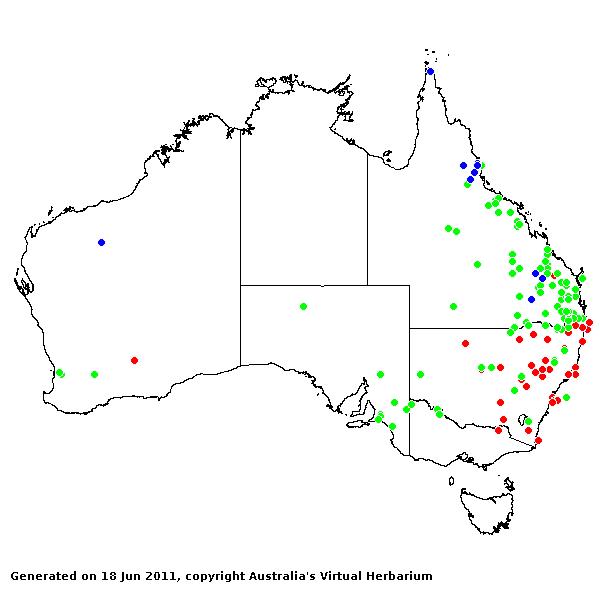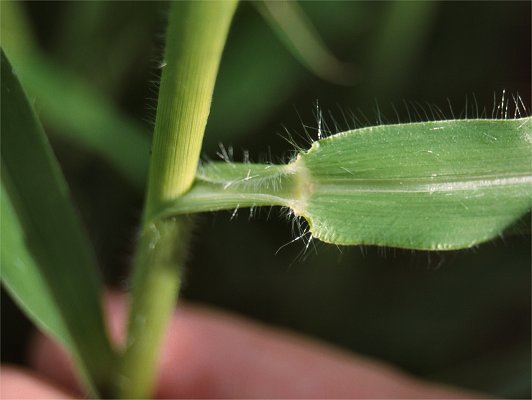Urochloa panicoides* Beauv. Ess.
Agrost. 53 (1812).
Classification. (GPWG 2001) : Subfamily
Panicoideae. Paniceae.
Type of Basionym or
Protologue Information: NT: P. Beauv., Ess. Agrost. pl. 11, f. 1 (1812),
NT designated by Veldkamp, Blumea 41: 433 (1996).
HT: Commerson in de Jussieu s.n., Mauritius
(P (lost)). According to Veldkamp, the type "could not be found"
at G or P.
Key references
(books and floras): [1878] G.Bentham, Flora Australiensis 7 (476 as Panicum
helopus), [2002] D.Sharp & B.K.Simon, AusGrass, Grasses of Australia,
[2006] J.Jessop, G.R.M.Dashorst, F.M.James, Grasses of South Australia
(493), [2008] S.W.L.Jacobs, R.D.B.Walley & D.J.B.Wheeler, Grasses of New
South Wales (396).
Illustrations:
[2006] J.Jessop, G.R.M.Dashorst, F.M.James, Grasses of South Australia (492, fig. 425 as var. panicoides),
[2008] S.W.L.Jacobs, R.D.B.Whalley & D.J.B.Wheeler, Grasses of New South
Wales, 4th edn (396).
Habit. Annual.
Rhizomes absent. Stolons absent. Culms geniculately ascending or decumbent,
10–100 cm tall. Mid-culm internodes glabrous or pubescent. Mid-culm nodes
pubescent. Ligule a fringed membrane or a fringe of hairs. Leaf-blades linear
or lanceolate, 2–25 cm long, 3–18 mm wide. Leaf-blade surface glabrous or
indumented.
Inflorescence.
Inflorescence compound, a panicle of racemes. Racemes 2–7(–10), 1–7 cm long,
0.9–1.2 mm wide. Central inflorescence axis 1–9 cm long.
Spikelets.
Spikelets sessile and pedicelled. Fertile spikelets 2-flowered, the lower
floret barren (rarely male), the upper fertile, comprising 1 basal sterile
florets, comprising 1 fertile floret(s), without rachilla extension, elliptic,
dorsally compressed, (2.5–)3.5–4.9(–5.5) mm long. Rhachilla internodes brief up
to lowest fertile floret.
Glumes.
Glumes dissimilar, thinner than fertile lemma. Lower glume ovate, membranous,
without keels, 3–5 -nerved. Lower glume surface glabrous or indumented. Upper
glume elliptic, 3.4–4.9 mm long, membranous, without keels, 7–13 -nerved. Upper
glume surface glabrous or indumented. Upper glume apex muticous. Florets.
Basal sterile florets 1, male or barren, with palea. Lemma of lower sterile
floret 100 % of length of spikelet, membranous, 5–7 -nerved.
Fertile lemma 2–3.1 mm
long, without keel. Lemma apex mucronate or awned. Median (principal) awn 0.3–1
mm long overall.
Continental
Distribution: Africa, Temperate Asia, Tropical Asia, Australasia, North
America, and South America.
Australian
Distribution: Western Australia, South Australia, Queensland,
New South Wales.
Western Australia: Ashburton. Irwin, Avon, Coolgardie. South Australia:
Eyre Peninsula, Murray,
Southern Lofty. Queensland: Burnett,
Cook, Darling Downs, Leichhardt, Maranoa, Mitchell, Moreton, North Kennedy,
Port Curtis, South Kennedy, Warrego, Wide
Bay. New South Wales:
North Coast, Central Coast, South Coast, Northern Tablelands, North-Western
Slopes, Central-Western Slopes, North-Western Plains, South-Western Plains,
North Far Western Plains.
Notes.
Introduced; Brigalow forests, tropical and subtropical sub-humid woodlands,
semi-arid shrub woodlands, and acacia shrublands. Flowers Feb.-May.
Infra-specific taxa: var. panicoides, var. pubescens.
Spikelets glabrous U. panicoides var. panicoides
Spikelets pubescent U. panicoides var. pubescens






